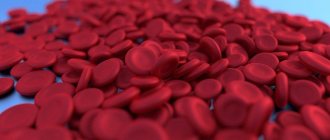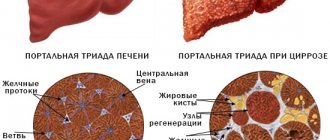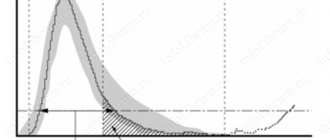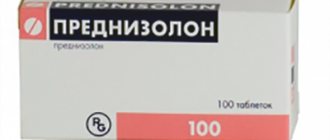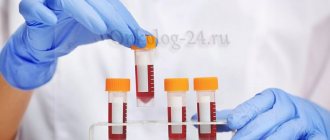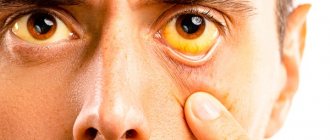Hemoglobin norm and diagnostic features
The level of hemoglobin in the blood is determined using laboratory diagnostics. The patient's blood is taken from a vein to make a general analysis. It is usually carried out in the morning on an empty stomach.
Hemoglobin is measured in grams per liter (g/L). And here are its indicators that are normal for a healthy person.
Normal hemoglobin levels:
- for women - 120–150 g/l;
- for men - 130–160 g/l.
If the number is less than the lower limit, then hemoglobin is reduced, and vice versa. But there are certain diagnostic features that you should be aware of.
In children, hemoglobin levels vary depending on age. In women, its level may decrease during menstruation; this is quite normal. A slight reduction is acceptable even if you are pregnant. Therefore, do not be alarmed by the numbers displayed in the analysis results and ask a specialist for interpretation.
What is the normal hemoglobin level and when should it be lowered?
If for women the norm is hemoglobin from 120 to 140 grams/liter, then for men these values should vary between 140-160 grams/liter. Doctors do not fully agree on what is considered high hemoglobin and what is considered normal.
Many doctors suggest that a deviation from the upper values of 20 units is considered increased. Others prefer to start treatment even if hemoglobin increases by 1 unit. If only a few points are missing from the norm, you can use non-drug methods of influence.
When hemoglobin is too high, it is necessary to use the entire available arsenal to quickly lower the levels.
Why is elevated hemoglobin dangerous?
Some people believe that high hemoglobin is a sign of excellent health. In fact, such patients experience increased blood viscosity, which leads to thrombosis.
A severed blood clot that travels through the body poses a danger to life.
It can impair the functioning of the heart or lungs - and be fatal in a matter of moments. The general condition of the patient also worsens, who, without examination, does not even suspect the true causes of the illness.
Signs of increased hemoglobin in the blood in men and women:
- Pallor of the skin,
- Weakness,
- Painful sensations in joints and muscles,
- Loss of appetite,
- Increased fatigue
- Headache,
- Skin itching
- Insomnia,
- Increased pressure.
It is not necessary that all the signs are present in one patient, but even some of the problems indicate the need to urgently reduce hemoglobin by adjusting the diet and using appropriate medications. In addition, an increase in hemoglobin may indicate serious pathologies of internal organs and systems.
Diseases that affect hemoglobin levels:
- Cardiovascular pathologies: heart failure, defects.
- Diabetes mellitus of any type.
- Intestinal obstruction.
- Oncological diseases.
- Pulmonary fibrosis.
- Blood thickening.
Also, hemoglobin levels increase under the influence of unfavorable environmental factors, due to dehydration and while taking steroid drugs. When a dangerous symptom appears due to diseases of the internal organs, it is necessary to deal with the underlying problem.
If the failure occurs due to external factors, special medications and diet adjustments are required, which will help to safely reduce hemoglobin.
Reduced hemoglobin
Why does hemoglobin drop?
The main reasons, in addition to those mentioned above, are:
- insufficient iron content in food, lack of vitamin B12 (folic acid);
- infectious diseases (hepatitis, pyelonephritis, tuberculosis, pneumonia, intestinal infections, etc.);
- diseases of the circulatory and endocrine systems;
- physical and psycho-emotional stress;
- dieting;
- smoking.
Anemia is the most serious complication of low hemoglobin. This condition is accompanied by general weakness, disturbances in sleep and thought processes. In addition, such a deviation from the norm aggravates any chronic diseases. A decrease in hemoglobin to a level of 70 g/l is considered life-threatening.
How to suspect you have low hemoglobin: mini-test
Want to know if everything is okay with your hemoglobin? Answer yes or no to the questions below.
- Are you plagued by drowsiness, poor health, dizziness?
- Do you get tired easily?
- Do you want unusual taste sensations? For example, are you tempted to try chalk, clay, sand, dough?
- Do you experience olfactory oddities: attracted by the smell of paint, acetone, mothballs, car exhaust, etc.?
- Are you pale?
- Do you notice a deterioration in the condition of your hair and nails?
If you answered “yes” two or more times, we invite you to Best Clinic for diagnostics.
Is it possible to reduce it at home?
Initially, it is necessary to find out the reason for the increase in hemoglobin; if this is a disease, it must be treated. It will not be possible to reduce hemoglobin independently and quickly at home without appropriate therapy.
As a short-term measure to reduce elevated hemoglobin in the blood, folk remedies can be used:
- leeches;
- mumiyo;
- herbal medicine.
A mandatory component of any therapy is adherence to a special diet.
Increased hemoglobin
Is it dangerous?
High hemoglobin is a symptom of other, more serious disorders in the body. This deviation often occurs against the background of:
- cardiovascular and respiratory failure;
- hormonal abnormalities;
- intestinal obstruction;
- diabetes mellitus;
- cancer;
- excess of vitamins B9, B12.
Do I need to go to the doctor?
Absolutely yes. After all, if you leave this phenomenon unattended, consequences may arise:
- Sickle anemia is a change in the shape of red blood cells. The disease is accompanied by weakness, thrombosis, edema, arthritis, sensitivity to bacterial infections, etc.
- Thrombophlebitis and thromboembolism - increased hemoglobin makes the blood thicker. This leads to the formation of blood clots.
- Blood viscosity with high hemoglobin can provoke heart attack and stroke.
Elevated hemoglobin is not always a pathology. For people who live in the mountains and work at high altitudes, this is only a mechanism for the body to adapt to extreme conditions.
High hemoglobin: we diagnose it ourselves
Please answer - is it true that you have:
- Are you experiencing general weakness, drowsiness, fatigue?
- Have redness appeared in certain areas of the skin?
- Do you occasionally experience short-term visual disturbances?
- Increased blood pressure?
- Has your appetite worsened?
If you agree with two or more statements, donate blood. Remember: increased hemoglobin is a symptom of serious diseases!
Symptoms of hemoglobin abnormalities
It is interesting that both an increase and a decrease in hemoglobin in the blood manifests itself in similar symptoms. Having noted the most common ones below, contact your doctor for a referral for a hemoglobin blood test:
- fast fatiguability,
- drowsiness and lack of vitality in the morning,
- headache and dizziness,
- pale skin,
- complete or partial loss of appetite,
- visual impairment,
- disturbances in the functioning of the genitourinary organs.
A person can notice the external symptoms of increased hemoglobin himself, but the internal state of a person with increased hemoglobin is much more dangerous. At this time, the blood becomes thick and viscous, which leads to the formation of plaques and blood clots, which in turn can cause a heart attack or stroke.
A reduced hemoglobin content is also manifested by:
- heart murmur
- shortness of breath,
- constantly cold hands and feet,
- fainting,
- muscle weakness,
- hair loss and brittle nails,
- addiction to special smells that other people find unpleasant.
Low hemoglobin levels are more common in older people. It also develops against the background of chronic stress, fatigue, and unbalanced nutrition.
Correction of hemoglobin level
To normalize hemoglobin levels, joint efforts are needed: yours and the doctor’s. Medicines alone cannot do this. First of all, you need to adjust your diet and follow a diet. The latter is extremely important and depends entirely on you.
Nutrition for low hemoglobin
To increase hemoglobin, increase your intake of vitamins and minerals:
- ascorbic acid (found in citrus fruits, rose hips, sea buckthorn, persimmon, garlic, parsley);
- vitamin B12 (meat, liver, kidneys, fish and seafood);
- iron (pomegranate juice, spinach, beets, buckwheat, pistachios, liver, legumes, cocoa).
Iron is found in many plant foods. But by-products are considered its most valuable sources. Iron obtained from animal products is absorbed approximately 3 times better than from plants. Beef and veal liver are leaders in the content of this element.
Avoid tea, coffee, and alcohol if your hemoglobin is low. These drinks interfere with iron absorption.
Nutrition for high hemoglobin
The main condition of the diet for high hemoglobin is the consumption of large amounts of fluid. Try to drink more clean water, include soups in your daily menu. Remembering this rule is especially important for those who sweat a lot. Increased fluid loss is typical for manual workers, athletes and absolutely everyone during the summer.
Avoid diuretic foods and drinks, they help remove fluid from the body. Among the products that remove liquid are lingonberries, cranberries, viburnum, rowan, and coffee. All red vegetables and fruits are a source of iron and increase hemoglobin, so you should not eat them. Watermelons, melons and cucumbers should also be included in the list of prohibited foods.
Basic nutrition rules
To correct hyperhemoglobinemia, it is not enough to use only folk remedies. During therapy you should also follow a special diet:
- Exclusion of animal foods rich in proteins (meat, especially liver). Preference should be given to fish and other seafood.
- Increased consumption of vegetables and fruits, cereals. It is recommended to include in your diet salads based on fireweed, wood lice and chickweed.
- Drinking freshly squeezed fruit juices. At least 400 ml per day.
- When taking multivitamin complexes, avoid those that contain folic acid, iron, and vitamins B and C.
See also:
- 12 herbs that purify the blood
- 7 plants that strengthen blood vessels
Drug treatment at Best Clinic
Your doctor should adjust your hemoglobin level. Folk remedies in this matter are not helpers, but even opponents.
Treatment for low hemoglobin
Before starting treatment, it is important to understand what is going on. There are three main reasons for low hemoglobin: lack of vitamin C, folic acid or iron. To find out for sure, the doctor will order tests. And taking into account their results, he will develop a course of therapy.
To correct low hemoglobin and anemia, iron supplements, poly- and monovitamins are often used.
If you are on a diet to reduce hemoglobin at the time of your visit to your doctor, please let us know. An excess of vitamins and microelements can negatively affect your health.
Treatment for elevated hemoglobin
Here, in addition to medications, additional correction methods are widely used. Among them are erythrocytapheresis and hirudotherapy.
Using erythrocytepheresis, excess red blood cells are removed from the bloodstream, thereby lowering hemoglobin. And hirudotherapy is treatment with leeches. The method may seem suspicious to some, but its effectiveness has been confirmed by numerous tests and patient reviews. Therefore, today hirudotherapy is considered a very promising treatment method.
You can find out your hemoglobin level and correct it with the help of Best Clinic doctors. Leave a request on the website and we will contact you immediately.
Why is the level of Hb in the blood elevated?
Hemoglobin is responsible for the transport function - the transfer of oxygen throughout the body. This gas is vital for all cells. Therefore, the hemoglobin level should be within normal limits, which leaves:
- 130-160 g/liter for men;
- 120-140 g/liter for women.
A deviation of the indicator in one direction or another is a dangerous symptom. So, a high hemoglobin concentration can occur due to:
- kidney diseases: hypernephroma, polycystic disease;
- pathologies of the heart and lungs: congenital heart disease, emphysema, pneumoconiosis and others;
- dehydration of the body;
- with the development of Vaquez's disease (a malignant change in the blood, in which the production of red blood cells increases significantly).
An increased concentration of hemoglobin in the blood is found in residents of mountainous regions, which is normal for them, since they live in conditions of lack of oxygen, to which the body adapts by producing more red blood cells.
